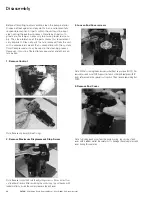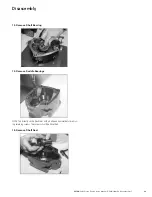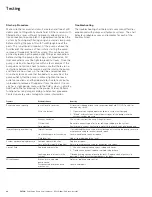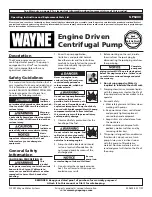
EATON
PVM Piston Pump Service Manual E-PUIO-II001-E4 December 2017
46
Start–up Procedure
Make sure the reservoir and circuit are clean and free of dirt/
debris prior to filling with hydraulic fluid. Fill the reservoir with
filtered oil to a level sufficient to prevent vortexing at suc-
tion connection to pump inlet. It is good practice to clean the
system by flushing and filtering using an external slave pump.
Before starting the pump, fill with fluid through one of the
ports. This is particularly important if the pump is above the
fluid level of the reservoir. When initially starting the pump,
remove all trapped air from the system. This can be accom-
plished by loosening the pump outlet fittings or connections
before starting the pump or by using an air bleed valve. All
inlet connections must be tight to prevent air leaks. Once the
pump is started it should prime within a few seconds. If the
pump does not prime, check to make sure that there are no
restrictions between the reservoir and the inlet to the pump,
and there are no air leaks in the inlet line and connections.
Also check to make sure that trapped air can escape at the
pump outlet. After the pump is primed, tighten the loose
outlet connections, and then operate for five to ten minutes
(unloaded) to remove all trapped air from the circuit. If reser-
voir has a sight gauge, make sure the fluid is clear – not milky.
Add fluid to the reservoir up to the proper fill level. Perform
functional test on pump according to Eaton test procedure.
Contact your area sales manager for more information.
Troubleshooting
The troubleshooting chart below lists common difficulties
experienced with pumps and hydraulic systems. The chart
indicates probable causes and remedies for each of the
troubles listed.
Testing
Trouble
Probable Cause
Remedy
Excessive noise in pump
low oil level in reservoir
fill reservoir to pepper level with recommended fluid. DO NOT overfill or
damage may result.
Air in the system
1. Open reservoir cap and operate hydraulic system until purged.
2. “Bleed“ hydraulic lines at point downstream of the pump while the
system is under pressure.
Vacuum condition
Check inlet (suction) lines and fittings for leaks.
Oil tool thick
Be certain correct type of oil is for refilling or adding to the system.
Cold weather
Run hydraulic system until unite is warm to the touch and noise disappears.
Hydraulic pump over heating
Internal leakage
If established that excessive internal leakage exist within the pump, return to
maintenance shop for evaluation and repair.
Heat exchanger not functioning
Locate trouble and repair or replace.
Fluid level low
Add oil to proper operating level.
System not developing pressure Compensator malfunction
Replace or repair.
Loss of fluid internally (slippage)
Return to maintenance shop for evaluation and repair.
Loss of fluid
Ruptured hydraulic line
1. Check all external connections, tubing and hoses.
2. Tighten connections, replace ruptured tube or hose.
Leaking gaskets or seals in the
Observe mating section of pump for leaks. Replace seals of gaskets in
system
possible. Check all system components for leaks.
Miscellaneous
Broken or mis-adjusted
Adjust or replace pump control.
pump control
Disconnected or broken drive
Locate and repair.
mechanism



































